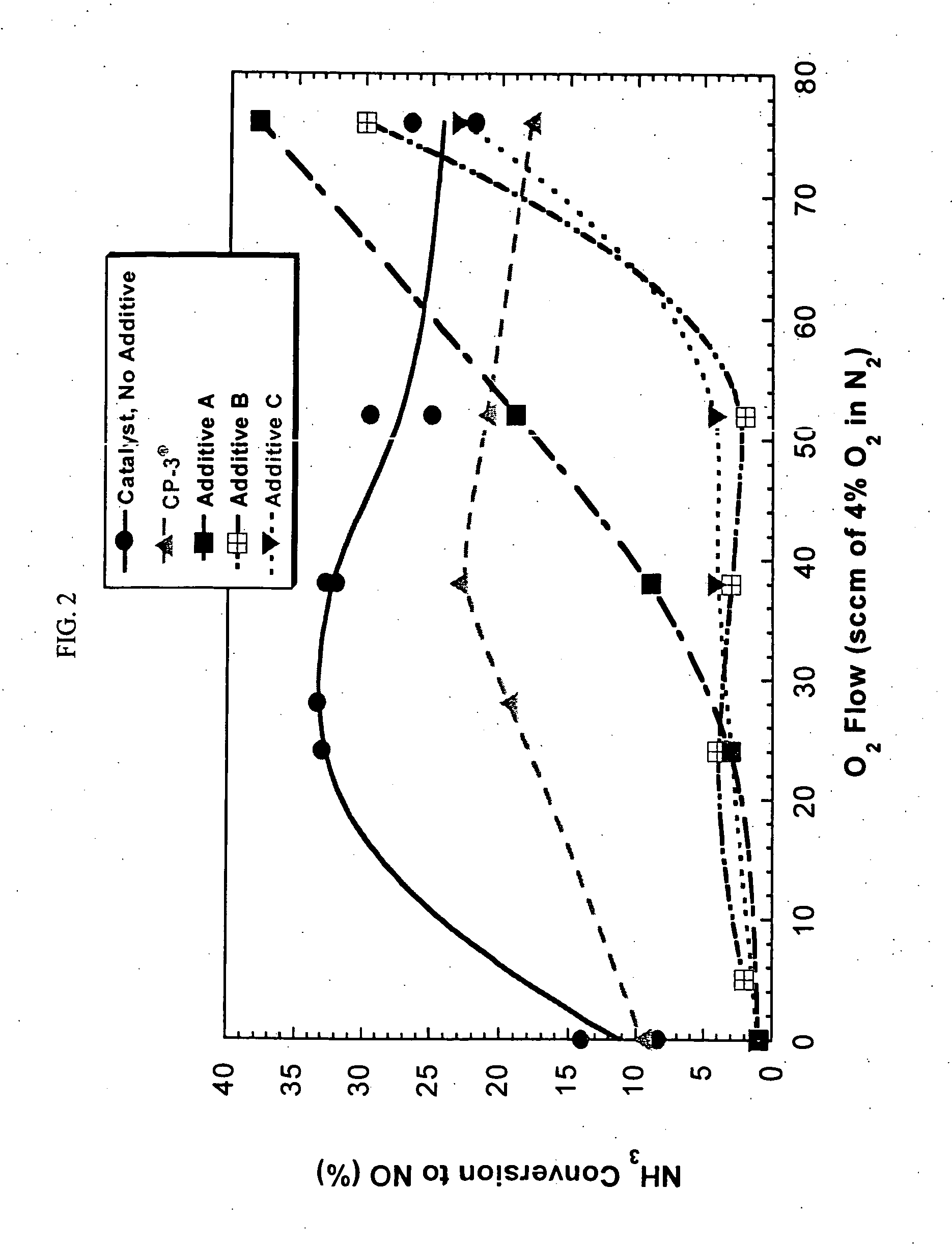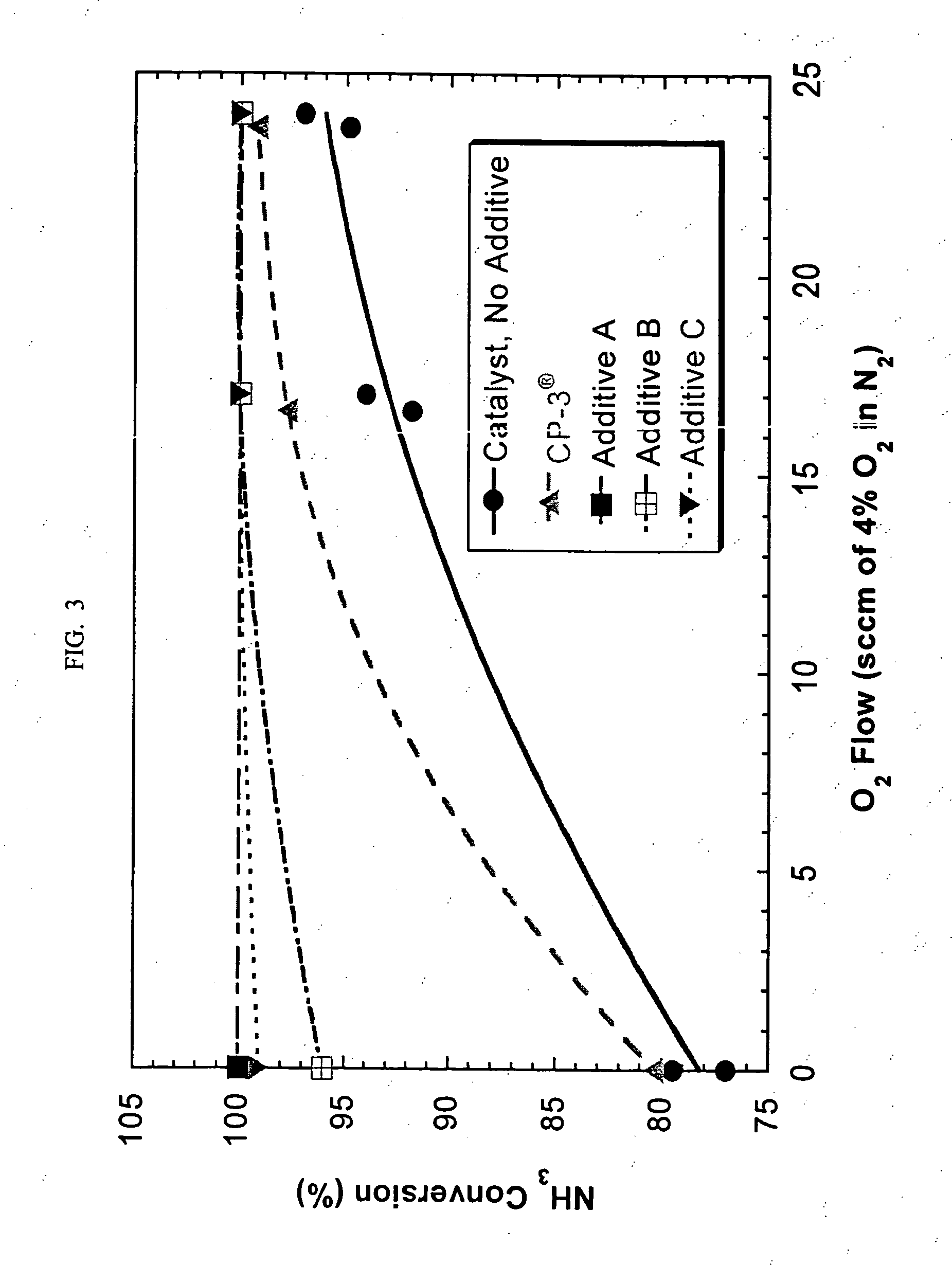NOx reduction compositions for use in FCC processes
a technology of nox reduction and composition, which is applied in the direction of catalyst activation/preparation, metal/metal-oxide/metal-hydroxide catalyst, and combustible gas purification/modification, etc. it can solve the problems of nox emissions, nox oxides, and insufficient oxygen to convert/burn all reducing species regardless, so as to reduce nox emissions and improve the effect of partial or incomplete combustion of fcc processes
- Summary
- Abstract
- Description
- Claims
- Application Information
AI Technical Summary
Benefits of technology
Problems solved by technology
Method used
Image
Examples
example 1
A silica-alumina slurry was prepared by adding 30 pounds of SRSII silica-alumina powder to 57 pounds of water that have been heated to 38 IC. (SRSII sold by Grace Davison, a Business Unit of W.R. Grace & Co.-Conn., in Columbia, Md., silica-alumina powder contained 6% SiO2, 94% Al2O3 and had a moisture content of 33%.) The slurry was prepared in a steam-jacketed stainless steel tank fitted with an electric powered agitator. Six pounds of an aqueous hydrochloric acid solution (35% HCl) and 6.7 pounds of an aqueous aluminum chlorohydrol solution (22% Al2O3) were added to the silica-alumina slurry. The mixture was heated to 55° C. and allowed to age at this temperature for 4 hours with continuous agitation. After the age period, 15.3 pounds of cerium carbonate crystals (obtained from Rhone Poulenc, Inc., 96% CeO2, 4% La2O3, 50% moisture) was added to the tank and 30 pounds of water were added to the tank to reduce the solid content of the slurry to 20 wt %.
The mixture was milled in a...
example 2
An aqueous slurry of peptizable alumina was prepared by combining 27.8 pounds of Versal-700 alumina powder (obtained from LaRoche Industries, Inc., 99% Al2O3, 30% moisture) with 52 pounds of water at room temperature in a well agitated tank. While mixing, 2.7 pounds of a sodium hydroxide solution were slowly added to the slurry and the mixture was aged for 20 minutes at room temperature. At the end of the age period, 4.5 pounds of a sodium silicate solution (27.3% SiO2, 5.7% Na2O) and 13.6 pounds of cerium carbonate crystals were added to the slurry. Additional water was added to the slurry to bring the solids concentration to 12%. The material was milled, spray dried and calcined using the methods described in Example 1. The final composition had the following analysis: 67.4% Al2O3, 4.3% SiO2, 22.9% CeO2, 0.9% La2O3 and 4.5% Na2O.
example 3
An aqueous solution was prepared consisting of 3 pounds of Lignosite-823 surfactant (obtained from Georgia-Pacific West, Inc.) in 180 pounds of water at room temperature. Twenty six pounds of Versal-700 alumina powder (obtained from LaRoche Industries, Inc., 99% Al2O3, 30% moisture) and 29.3 pounds of an aqueous formic acid solution (45% CH2O2) were added to the Lignosite solution. The slurry was allowed to age for 10 minutes with continuous agitation and then 12 pounds of cerium carbonate crystals were slowly added with continuous agitation. The slurry was milled, spray dried and calcined as described in Example 1 above.
The calcined product was loaded into an Eirich mixer and sprayed with a aqueous solution of sodium silicate containing 9.2% SiO2 and 1.92% Na2O. The impregnated material was dried in an oven at 120° C. overnight and calcined for 2 hours at 675° C. The product was impregnated again with an aqueous solution of sodium carbonate containing 7.0% Na2O, followed by dryi...
PUM
| Property | Measurement | Unit |
|---|---|---|
| mean particle size | aaaaa | aaaaa |
| wt % | aaaaa | aaaaa |
| alkaline earth metal | aaaaa | aaaaa |
Abstract
Description
Claims
Application Information
 Login to View More
Login to View More - R&D
- Intellectual Property
- Life Sciences
- Materials
- Tech Scout
- Unparalleled Data Quality
- Higher Quality Content
- 60% Fewer Hallucinations
Browse by: Latest US Patents, China's latest patents, Technical Efficacy Thesaurus, Application Domain, Technology Topic, Popular Technical Reports.
© 2025 PatSnap. All rights reserved.Legal|Privacy policy|Modern Slavery Act Transparency Statement|Sitemap|About US| Contact US: help@patsnap.com



